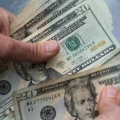There was nothing normal about the COVID-19 recession. The onset of the pandemic, coupled with state-issued lockdowns, put the economy into its sharpest contraction in U.S. history. In a matter of two months, more than 22 million workers lost their jobs.
In response to the unprecedented nature of the crisis, lawmakers turned to new forms of economic aid. That included everything from generous enhanced unemployment benefits to forgivable small-business loans (through the program known as PPP). But none was more popular than stimulus checks. The first round of $1,200 checks was issued through the $2.2 trillion CARES Act, which passed in March 2020; as a result of both economic need and political popularity, it would be followed by checks issued in December 2020 and March 2021 of $600 and $1,400, respectively. (In each round, some higher-income individuals got smaller checks, or no checks at all.)
The wind-down of the coronavirus crisis should be the end of the road for stimulus checks in America, right? Well, not necessarily. While a fourth nationwide stimulus check is not in the works, it doesn’t mean stimulus programs are one for the history books. Here are four things to know about the future of stimulus checks in 2022 and beyond.
While some progressive activists are pushing for another check, neither Democratic nor Republican leadership is on board with another direct payment. The same goes for President Biden: When asked about it earlier this year, White House press secretary Jen Psaki told reporters that a fourth check wasn’t on the administration’s to-do list, and noted the checks “were not free.” She’s right: Stimulus checks don’t come cheap. The last round of $1,400 checks cost the federal government around $400 billion. For comparison, the combined GDP of North Dakota, Rhode Island, South Dakota, Montana, Alaska, Wyoming, and Vermont is just above $350 billion.
Secondly, the economy is doing much better now. Since May 2020, the economy has added 17.4 million jobs. The September unemployment rate of 4.8% is slightly below the 5% figure that economists have historically considered “full employment.” And it’s a far cry from the 14.8% rate hit in April 2020.
Simply put, the odds of Congress passing a fourth stimulus check are close to zero.
The $1.9 trillion aid package signed into law this March by Biden sent most American households a third stimulus check. But some households are owed another check of up to $1,400: Reporting by Insider and Fortune discovered earlier this year that a stimulus check would indeed go out to eligible parents of 2021 newborns once they file their tax returns next year.
See, those $1,400 checks were sent out based on the last tax return on file—so they didn’t include 2021 newborns. That’s why the check will get applied to parents’ and guardians’ 2021 tax returns. Of course, taxpayers would still need to meet the income requirements. You can find those eligibility details at this link.
It took no time for Americans to get on board with stimulus checks. Back in March 2020, a Fortune-SurveyMonkey poll found that 89% of Democrats and 85% of Republicans supported a one-time direct payment. Its popularity didn’t stop there: Democrats arguably used the promise of a $2,000 stimulus check to win the two Georgia Senate runoff races in January.
Those victories, of course, gave Democrats control of the U.S. Senate and the power to pass the third check in March.
Those direct payments certainly had an impact on the broader economy. Look no further than a study by University of Michigan researchers that found the checks coincided with a drop in financial instability among recipients. However, the economic benefits aren’t why stimulus checks are poised to be a lasting policy creation of the COVID-19 recession. Instead, it’s the popularity and political power of the checks.
“The politics of it suggest there will be future stimulus checks,” Moody’s Analytics chief economist Mark Zandi told Fortune this summer. Amid future recessions, Zandi says, lawmakers will surely face pressure from some voters to issue direct payments.
On Friday, Golden State residents will have one final chance to submit their tax return and claim their second state-issued stimulus check. In total, around two-thirds of the state’s residents were eligible for California’s second COVID-19 stimulus check.
California isn’t the only state that issued its own direct payment. Maryland also issued a stimulus check, while Texas and Florida each did a round for teachers. Those state payouts, similar to the national checks, are very popular.
That popularity combined with political considerations (after all, California Gov. Gavin Newsom did issue this second round amid his recall election campaign) are why state-level checks could stick around long after this pandemic ends.









Leave a Reply